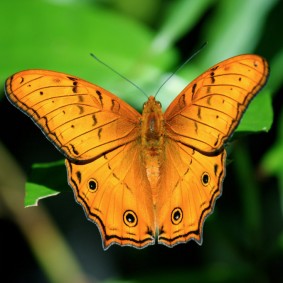
Base Camp C was established one and a half hour’s walk beyond the village of Kanikeh, in a shady clearing protected by giant bamboo. It was a magical setting. Between the tall, thick stems of bamboo and other rainforest trees there were fantastic vistas of Gunung Binaia which at times was hidden in soft, swirling cloud. Within a short distance of camp there was also a gentle cool, stream with a secluded pool where we bathed. The camp’s pit toilets were dug well away from the stream that provided drinking water for the expedition and the village of Kanikeh.
Rats ‘n bats and flutterbies
It was always a little unnerving making the trip to the toilet because I was never sure if I was going to encounter a jet black, venomous snake that regularly basked in the sunlight that lit the cleared path to the toilets. It simply meant being alert and treading carefully. Other more welcome wildlife were the beautiful butterflies that gathered on rocks at the river’s edge to drink. It was in the open flyway over the water that we set mist nets to capture fruit bats and harp traps to capture smaller insectivorous bats. We also set baited box traps in the forest and the banana groves to catch small ground-dwelling mammals. Melomys rats with their marbled tails, large dark eyes and gentle nature were very cute while the shrews with their tiny eyes, long pointed snout and strong unpleasant smell, were completely new to me and so quite intriguing.

Just add water
The foundation of our diet for the 3 months we were on Seram as supplied by Operation Raleigh were army rations. This meant that we lived off a limited menu of dried foods that were provided in small, sealed packages. We simply added water and heated the ingredients. The meals weren’t too bad but it didn’t take long before we were craving fresh fruits, vegetables and meat. The topic of conversation around the camp often came back to food and we all daydreamed about what we would be tucking into when we got home.
Breakfast was something that resembled finely ground oats sweetened with sugar, with or without sultanas. I actually relished breakfast, especially when I could get it with sultanas, but others found it pretty hard to stomach. Luxury items during our stay on the island included sticks of sugarcane, some fruits and deer meat supplied by the villagers and an alcoholic drink that some crafty venturers had brewed in tubs in the base camps.
White gold
We were also given energy bars, which came in very handy on the long hikes. One was like a pure white stick of peppermint-flavoured sugar. The first time that I tried one of these, it was sickly sweet and I gave mine away but later some of us began trading food items to get more of the sugar bars because they were a welcome boost on long, arduous hikes.
One special experience I shall always remember was on the hike from Kanikeh to Manusela through the central mountains of Seram. Halfway along the trail we met a small group of local men traveling the opposite way. Though they only had limited supplies, they gladly offered us some of their prized sugar cane. We gratefully accepted this gift and then happily munched and sucked on the tough, green sticks trying to extract every last drop of sugary, energy-giving syrup. This was not the first or the last time that I felt humbled at the generosity of a people who lived such simple lives in pretty tough circumstances.
Go to ‘Base Camp C’ Photo Gallery
Photos by Kai Bansner

